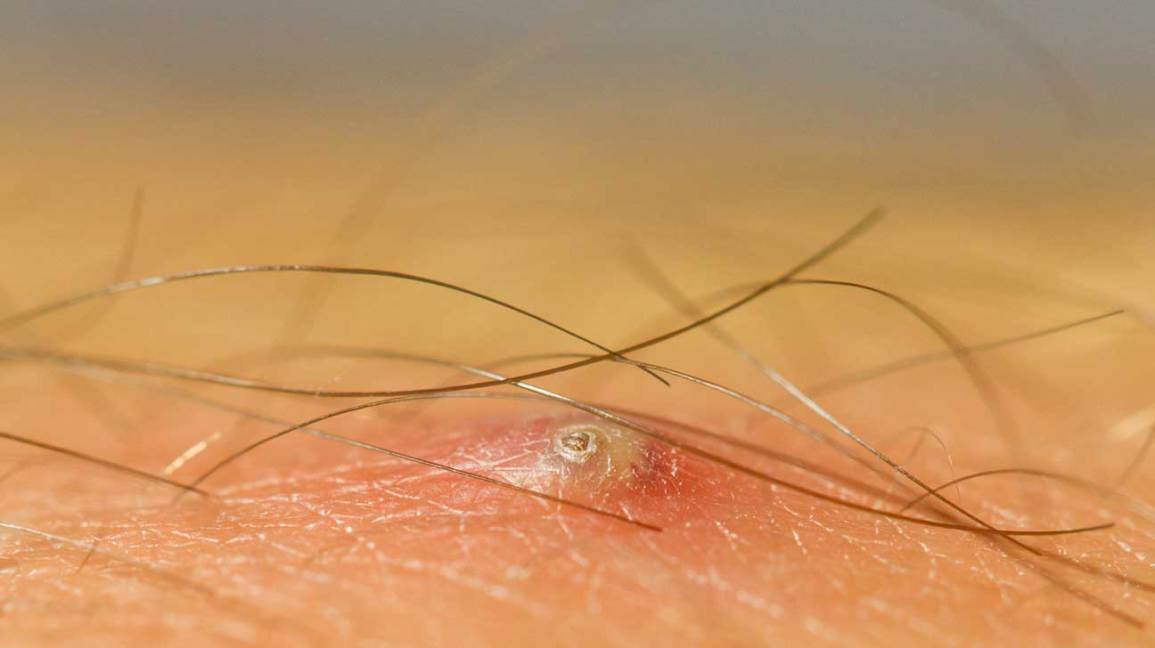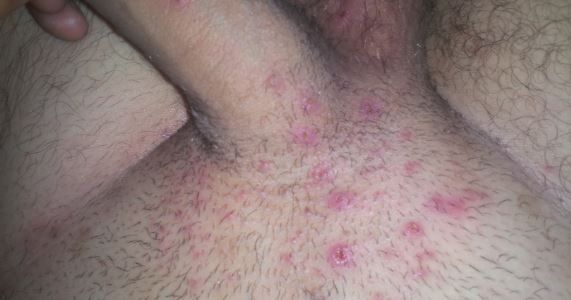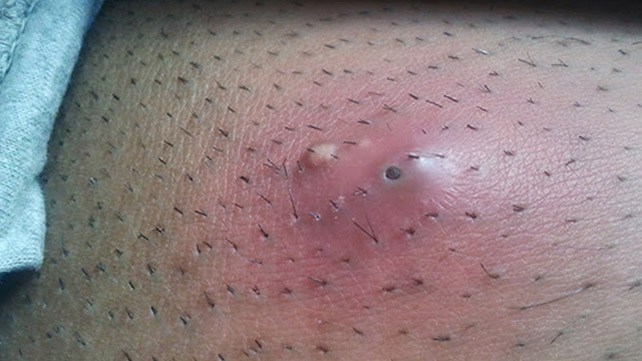Ingrown hair on penis base or penile shaft can be itchy, painful and unsightly. Shaving and waxing are the main cause of embedded hairs on the pubic area.
When left untreated, the bumps can become infected cysts that ooze pus. Scars can also result from these hairs. Here are pictures, treatment options and how to get rid of ingrown hair on the penile shaft.
- An ingrown hair occurs when “the sharp tip of the hair curls back or grows sideways into the skin of the hair follicle.”
- The result is normally an ingrown hair bump or pimple-like pustule on the skin.
- Embedded hairs can occur on any part of the skin. The penile shaft, base or entire pubic area can easily be affected with ingrown hairs.
Ingrown hair on penis pictures
Is it normal to get embedded hairs on the penile shaft and base? Any part of your body that has hair can get ingrown hair bumps.
These are usually preceded by razor burn and razor bumps. Although shaving is the main cause, you can also get the condition without shaving. What do ingrown hairs look like?
- Ingrowing hairs on the male pubic area, or any part of the skin appear as pinpoint tan bumps.
- The pimple like bumps on the penis may be pus-filled if infected.
- A typical characteristic of ingrown hair on penis shaft is a dark spot at the center of the bump or cyst.
- Here are ingrown hair on penile shaft pictures and images to help you identify your symptoms.
The benign condition can cause scars on the penis if not prevented. Note that some other conditions such as genital herpes can produce relatively similar symptoms. If you suspect the penile bumps and sores are not ingrown hairs, see a doctor as soon as possible.
Causes?
What causes ingrown penile hair? Waxing and shaving the male pubic area can easily cause a few side effects. According to MeicineNet, “Ingrown hairs tend to be more common in areas with coarse hairs, like the bikini area in women, and beard and neck in men. Individuals with thicker, curled hairs, such as African Americans, tend to have the highest rate of problems with ingrown hairs…”
1. Ingrown hair bump after shaving or waxing
Most men and women experience ingrown hairs in the pubic area after shaving. Shaving and other hair removal methods are followed by hair growing back. As hair grows back through the skin, any kind of obstruction can cause it to curl back and grow inward.
- Poor shaving techniques as seen below are a major contributing factor to ingrown hair on penis shaft and base.
- Also, as discussed below, shaving without preparing your skin adequately will likely cause ingrown hairs in the male pubic area.
Some people are highly prone to severe ingrown hairs. Such people are advised to reduce the number of times they shave in a month. This will help reduce and prevent painful ingrown hairs after shaving or waxing.
2. Poor shaving technique

Shaving your testicles, crotch and penile shaft or base is the main cause of ingrowing hair. But why shaving? Hair grows in a certain direction. Shaving against the direction of hair growth irritates the skin and causes razor bumps. It can also lead to ingrowing hair follicles on the penile shaft.
- To prevent ingrown hair, always shave along the grains. This means shaving in the direction of hair growth.
- Lather your skin adequately before shaving.
- Use sharp razors and clean them after every stroke.
The right shaving technique can always prevent ingrown hairs. If you get the bumps down there, or irritation on the skin, it is likely your shaving technique is inappropriate.
2. Genetic predisposition
Chronic ingrown hairs on the face, pubic region and beard area are sometimes linked to genetics. Some people, especially those with coarse, curly hair may suffer this problem after shaving.
In people with excessive sex hormones, excessive hair growth can also lead to ingrowing hair following a close shave. According to WebMD, “Many African-Americans, Latinos, and people with thick or curly hair develop a type of ingrown hair called pseudofolliculitis.” If you have the chronic problem of hair growing back into the skin after shaving, see a doctor for better treatment options.
3. Plugged hair follicles
When skin pores are blocked, ingrown hairs will form after shaving. This is because the hair growing through the skin gets obstructed and curls back into the skin. The result is an itchy hair follicle. Often, you will start to scratch the penile area with ingrown hair.
As the skin gets irritated, a red rash or red ingrown hair bump on penis may form. If it eventually gets infected, it will lead to a pus-filled bump or pimple.
- Hair follicles get clogged by dead skin cells, usually when you don’t exfoliate your skin regularly.
- Excessive production of oil in the hair follicles can also block the pores.
- According to skincareguide, people with dry skin are prone to ingrown hairs too. Dry skin has “a lot of dead skin cells, and these may often cover the pores, preventing the hair to surface.”
Proper exfoliation can help prevent ingrown hair on penis shaft and base. Scrub well days before shaving and avoid shaving immediately after exfoliation. This will irritate the skin and cause it itch. Note that excessive oil in skin pores may be caused by hypothyroidism, poor hygiene, hormonal problems and some creams that make the skin oily.
4. Keratosis pilaris may cause ingrown hairs
Keratosis pilaris is also called lichen pilaris or follicular pilaris. It is a genetic condition where a person naturally has what is sometimes called chicken skin. With this condition, your skin produces rough red bumps or rough brown bumps due to excessive dead skin cells.
According to Wikipedia, keratosis pilaris is caused by excessive production of keratin. Too much of this protein “surrounds and entraps the hair follicles in the pore.”
Most keratosis pilaris “bumps contain an ingrown hair that has coiled. This is a result of the keratinized skin’s “capping off” the hair follicle, preventing the hair from exiting.” The result is the hair on your pubic region or other parts of the skin with hair growing under the skin and causing the red, inflamed bumps.
Symptoms of ingrown hair on penile shaft and base
Some signs and symptoms can produce a lot of discomfort in the pubic area. The skin may itch and become irritated due to the ingrowing penis hair forcing itself sideways or downward.

The bumps that form can also become itchy and may contain pus. In general, the following are the symptoms of ingrown hair on penis and penile shaft.
- Small red bumps, called razor bumps. These occur after shaving balls, waxing or epilating hair.
- The red bumps contain a dark spot at the center. This is the head of the ingrowing hair follicle.
- When infected, you are likely to have an ingrown hair cyst or boil. The boil may ooze pus or a clear fluid if broken.
- After infection, the penis may get a scar upon healing. The scar is as a result of the broken skin.
Note that infected cysts or bumps may appear as yellow or white bumps. In some people, the pus may appear green. This is when the bacterial activity is at its highest and the infection on the bump or cyst in highest.
Infected ingrown hair cyst on shaft
Excessive oil or sebum, bacteria and dead skin cells in hair follicles can lead to an infection. Ingrown hair on penis with an infected cyst can cause pain and discomfort. Bacterial infections on the shaft will leave you with the desire to itch. The wound will also be unsightly.
An abscess or tender bump with fluid or pus in the genital area is unhygienic. It can cause further infections. It will leave your skin and hair follicles prone to bacterial and fungal infections.
In some people, the infection will lead to the swelling of angina glands in the groin. This is a painful hard lump due to a localized body defense mechanism.
- Scratching, squeezing and picking at razor bumps can lead to cysts.
- When infected, the cysts will turn into pus-filled sores.
- If the infection becomes severe, the cysts will become large and can turn into genital boils.
- Eventually, the infection will leave you with dark scars and dark spots on penis, scrotum or groin area.
How to remove ingrown hair on penis
If you have just a few ingrown hairs, you may consider removing them at home. Proper care and extraction of the embedded or curled hairs can be a solution for people without recurring bumps. Here’s how to remove ingrown hair on the penis base and shaft.
- Apply 1% hydrocortisone cream a few days before. This will help get rid of the inflammation on the bumps.
- Before removing the hairs under the skin, apply warm compresses three times a day.
- Repeat the warm compresses until you see the bent hair follicle under the skin.
- Wash the bump or cyst and apply anti-acne medication. You may use antiseptic soap to prevent infections.
- Sterilize your tweezers and a pin.
- Use the sterile pin to prick and open up the cyst, pimple or bump on your shaft.
- If pus-filled or blood-filled, lance it in order to drain the fluid.
- Slip the pointed end of the tweezers under the curled hair and pull it up gently.
- Ensure that you do not uproot the hair follicle.
- Treat the area with an antibacterial ointment. This will prevent further infections.
How to get rid of ingrown hair on penis (treatment)
In most cases, ingrowing hairs go away on their own. But when they remain persistent, they can become infected and leave you with scars and dark spots on the penis.
Big ingrown hairs and cysts can be removed by draining them first. Medications are also prescribed to get rid of ingrown hair on penis, face, neck etc.
- Apply hydrocortisone cream twice a day. This cream will reduce the inflammation on the bump and make it easy to pull out the embedded hair follicle.
- Apply a topical steroid cream to reduce the swelling and irritation.
- “Retinoids (Retin A) to remove dead skin cells and reduce the skin pigment changes that can occur from ingrown hairs.” – WebMD.com
- If you have infected ingrown hair on penis shaft, your doctor will prescribe antibiotic medication to get rid of the infection fast.
- Use salicylic acid or benzoyl peroxide to exfoliate and remove dead skin cells.
Mild cases of folliculitis will clear up without the need for treatment. Just try to avoid shaving for a couple of days or a week. Dabbing a mild antiseptic cream or ointment can help the bumps to heal faster. An example is tea tree oil. Remember that antibiotics are only prescribed when the skin on the penis, scrotum or groin is severely infected with pustules and abscesses.
Prevention
Preparing your skin before shaving is important in preventing hair from curling back into the skin. Start days before and prepare your penile base to ensure a smooth shave. Here are tips to prevent this condition easily.
- Always shave in the direction of hair growth. Shaving against it will irritate the skin and cause it to curl back.
- Exfoliate the pubic region – the penile base, scrotum and general groin area. Removing dead cells helps hair follicles to sprout without obstruction.
- Always use a single-bladed razor and clean it after every stroke.
- Avoid shaving too close to the skin. Leave a little bit of hair.
- Use a shaving gel every time you shave. Also, wetting your skin before shaving the penile base and shaft will prevent ingrown penile hair.
The most important thing to keep in mind is that holding your razor too close to your skin and scraping will cause ingrown penis hair.
Also, a dull razor will cause irritation. Dead skin cells should also be removed. It is recommended that you do this gently using a loofah because you can hurt the delicate skin on scrotum or balls.
Sources and references
- MeicineNet: Ingrown Hair Treatment and Removal
- Skincareguide: Causes of Ingrown Hair
- WebMD: Ingrown Hai+r Causes, Treatment, Infections
- WikiPedia: Keratosis pilaris
- NHS: Preventing Ingrown Hairs


